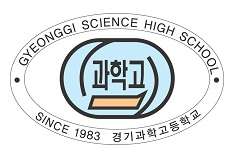Gyeonggi Science High School
Gyeonggi Science High School (GSHS, Korean: 경기과학고등학교), established in 1983 originally as a Science High school, is currently a science High school for the gifted in Suwon, South Korea. It was the first science high school established in South Korea, and was transformed into a science high school for the gifted, being one of the four in South Korea. It is the third been transformed from science high school to science high school for the gifted according to Gifted Education Promotion Law (Korean: 영재교육진흥법).[1]

| Gyeonggi Science High School | |
| Hangul | 경기과학고등학교 |
|---|---|
| Hanja | |
| Revised Romanization | Gyeonggi Gwahak Godeung Hakgyo |
| McCune–Reischauer | Kyŏnggi Kwahak Kodŭng Hakkyo |
| Motto | Patriotism, Creativity, Cooperation |
|---|---|
| Type | Science Academy for the Gifted |
| Established | 1983 |
| President | Park Wan-gyu |
Academic staff | 144 |
| Students | 384 |
| Location | , |
| Campus | 135 Suil-ro, Songjuk-dong, Jangan-gu, Suwon, Gyeonggi-do, South Korea |
| Website | gs |
Motto
History
- November 19, 1981: Draft for establishment of a Science High School confirmed by Gyeonggi-do Education Committee.
- May 15, 1982: Start of construction.
- July 15, 1983: Official School Inception.
- May 5, 1983: The first entrance ceremony (2 class, 60 boy students)
- February 10, 1984: Official visit by President Chun Doo-hwan.[2]
- February 1, 1986: The first graduation (graduation 54, completed 44)
- February 3, 1987: Designated as a Specialty High School.
- March 2, 1988: Began accepting girls and enrolled its first coeducational class.
- September 1, 1988: The second principal, Kang Sung-gi appointed.
- June 9, 1993: Official visit by President Kim Young-sam.[3]
- March 2, 1994: The third principal, Lee Seok-geun appointed.
- March 1, 1999: The fourth principal, Kim Jong-oh appointed.
- December 19, 2008: Officially designated as "Science Academy" by Ministry of Education, Science and Technology.[4]
- September 1, 2007: The sixth principal, Bu Seong-chan appointed.
- March 1, 2010: Officially named "Science Academy for the Gifted".
- March 2, 2010: The seventh, and current principal, Cheon Yeong-ho appointed.[5]
- July 2, 2010: Officially announced transition to "Science Academy for the Gifted".[6]
- January 22, 2011: Concluded MOU with South Carolina Governor's School for Science and Mathematics.
- August 3, 2011: Akira Suzuki (chemist), a Nobel Prize Laureate (2010), visited the school.[7]
- November 12, 2011: Concluded MOU with GIST.[8]
- February 21, 2012: Concluded MOU with UNIST.[9]
- February 1, 2013: The first Graduation after modified to “Science Academy for the Gifted”.
Admission policy
Admission procedure is consist of 4 steps. At the first step, students will be evaluated with their documents include introduction, recommendation, and a document that will prove the student's potential. Every one is accepted in this stage. At the second step, they will get through tests that will judge if he or she really are gifted. 2000 students are accepted here. At the third step, the last step, they are either preferentially accepted or attend to camp. About 120 students are finally accepted.
Curriculum
It is consist of 139 credits of academic courses and 33 credits of research activities.
- Academic courses (139)
- General courses include 26 credits of necessary courses and 32 credits of selective courses.(58)
- 4 credits of liberal arts.(4)
- Specialized courses include necessary course of 46 credits and selective courses of 31 credits.(77)
- Research activities (33)
- Self-directed Research(R&E) : 20 credits
- Field research : 8 credits
- Research for graduation : 5 credits
There are PT system, seasonal school system, and AP with various universities, such as KAIST, POSTECH, GIST, UNIST by MOU.
Graduation policy
To graduate from this school successfully, you have to fill in 4 criteria.
- Complete at least 172 credits.
- Get a score at least 650 in TEPS.
- Attend to group and voluntary activity each at least of 120 hours.
- Submit an own thesis in English.
External links
- (in Korean) Official site
- (in English) Official site
References
- http://www.suwon.com/news/articleView.html?idxno=35836
- http://dna.naver.com/viewer/view.nhn?editNo=2&printCount=&publishDate=1984-02-11&officeId=00032&pageNo=1&printNo=11807&publishType=00020&articleId=&serviceStartYear=1960&serviceEndYear=1995
- http://dna.naver.com/viewer/index.nhn?articleId=1993061000209104001&editNo=40&printCount=1&publishDate=1993-06-10&officeId=00020&pageNo=4&printNo=22196&publishType=00010
- http://www.donga.com/fbin/output?n=200812190152
- http://news.naver.com/main/read.nhn?mode=LSD&mid=sec&sid1=102&oid=001&aid=0003042178
- http://news.naver.com/main/read.nhn?mode=LSD&mid=sec&sid1=102&oid=001&aid=0003362852
- http://article.joinsmsn.com/news/article/article.asp?total_id=5897745&ctg=1200
- http://news1.kr/articles/891049
- http://www.joongboo.com/news/articleView.html?idxno=775642
